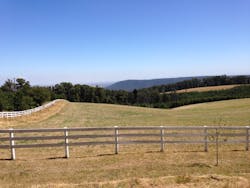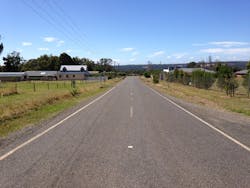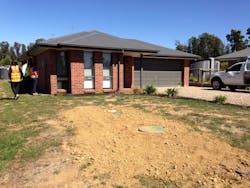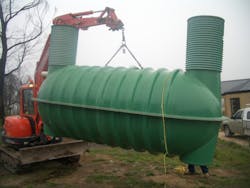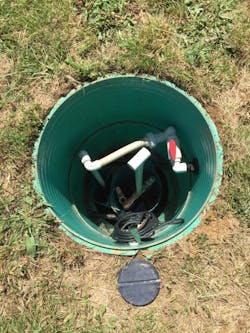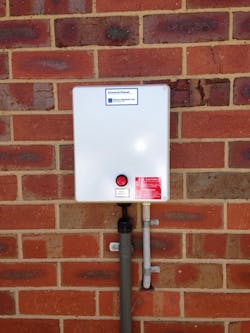Devastated community finds innovative wastewater solution
The community of Kinglake West, Victoria, Australia, was on a waiting list to receive government financing for a new sewer system when, in 2009, a disastrous fire swept through the area. The damage was so extensive that funding for a wastewater collection system was expedited. The new system needed to be up and running as soon as possible, without being an undue financial burden to homeowners.
The community of Kinglake West, home to about 1,000 residents, was dramatically impacted. Much of the town needed to be rebuilt, including its infrastructure. In particular, the community needed a collection system to transport wastewater from individual homes to a decentralized wastewater treatment plant.
One of the primary goals of Yarra Valley Water, the local water and wastewater authority, was to construct an innovative collection system that would be affordable and effective and would also provide some environmental benefits. Challenges included small lot sizes, steep gradients, and high rainfall.
With support from the community, Yarra Valley Water chose an Orenco® Effluent Sewer, a type of pressure sewer also known as a STEP/STEG system. This solution addressed the community’s challenges and offered many unique advantages, including:
• Watertight collection, with no need for manholes or expensive lift stations
• Shallowly buried, small-diameter sewer lines, quickly installed with light equipment
• Passive, on-lot primary treatment
• Reduced size, complexity, and cost of the wastewater treatment system
• A minimum of 24-hour emergency storage in watertight, on-lot tanks (with normal, daily flows)
• Low operation and maintenance costs for both collection and treatment
• Long-term sustainability
A Gradual Rebuilding
Kinglake West began the installation of its effluent sewer in 2010. The sewer includes an Orenco STEP (Septic Tank Effluent Pump) package in an underground tank, which provides passive, primary treatment at each residence. Small-diameter force mains move the effluent from each home to the community’s treatment facility. Because an effluent sewer transports only liquids, its mainlines are typically just 50–100 mm (2–4 inches) in diameter and can be installed quickly and easily with light-duty equipment. This allowed the wastewater collection system to be completed in a relatively short period of time, despite the area’s hilly terrain.
Another unique benefit of effluent sewers is their use of shallowly buried, small-diameter transport lines that follow the natural contour of the land. These lines can be installed using light-duty equipment such as a trencher, directional boring machine, or small excavator. This dramatically reduced the time, cost, and complexity of designing and installing the wastewater collection system. In stark contrast, a conventional gravity sewer system would likely have required deep excavations to install 200-mm (8-inch) mainlines, plus manholes and lift stations.
Considering the hilly terrain around Kinglake West, the installation of an effluent sewer was estimated to cost 40 percent less than that of a gravity sewer. The savings of $785,000 AUD ($727,000 USD) was large enough that Yarra Valley Water could have used it to pay for the installation of an effluent sewer for an entire second community of the same size.
Next, an Orenco STEP pumping package was installed at each property. The package includes a watertight interceptor tank, a Biotube® pump vault and filter, an Orenco high-head effluent pump, and a set of float switches. Once connected to the force main, primary-treated effluent from each home is pumped to the community’s wastewater treatment facility.
An Orenco Biotube pump vault is installed in each on-lot tank. The pump vault houses the filter, the pump, and the float switches. The Biotube filter consists of 3-mm (1/8-inch) mesh, which prevents the discharge of any larger solids. The organic matter retained in the tank is anaerobically digested by naturally occurring bacteria. Undigested solids accumulate slowly in the tank, so pump-outs are typically needed only once every ten years, depending on the number of residents in the home.
The pump typically comes on only 3–5 times a day for a total of less than 30 minutes. The float switches include a high-level alarm float, a pump on/off float, and a redundant off/low-level alarm float. Liquid is stored in the watertight tank until it reaches the float “on” level. The pump then engages until the liquid is reduced to the “off” level.
“The Kinglake West project was undertaken to determine whether it was possible to deliver a more sustainable sewerage solution in a developed, unsewered ‘community sewerage’ area,” Andrew Gellie, community sewerage planning manager for Yarra Valley Water, said. “We found the use of the STEP tanks to be a successful approach to extending wastewater services to this small community. The tanks allowed us to proceed with a staged approach to help Kinglake West rebuild.”
Low Operation and Maintenance Requirements
The operation and maintenance requirements of an effluent sewer are extremely low. Each residence and business connected to the system requires routine service only every other year. A typical service consists of measuring and recording solids accumulations in the on-lot tank, cleaning the Biotube filter and pump intake screen (if needed), and verifying proper operation of the pump, floats, and control panel. The valves in the system are also inspected and tested to make sure they’re in good working condition. Because solids aren’t pumped through the force main, flushing (or “pigging”) of the mainline isn’t required.
An Orenco Sewer allowed Yarra Valley Water to provide a feasible, long-term solution to its customers in Kinglake West soon after a major crisis.
“We benefited from reduced capital and operating costs for the collection system and sewerage treatment plant,” Gellie said. “This cost-effective technology has gone a long way toward helping the community rebuild and recover from the devastating fires of 2009.” WW
About the Author
Bill Hensley
Bill Hensley is an international project manager for Orenco Systems Inc., a wastewater equipment manufacturer. In his primary role, he manages engineered projects outside of the U.S. and Canada. Learn more at www.orenco.com.

